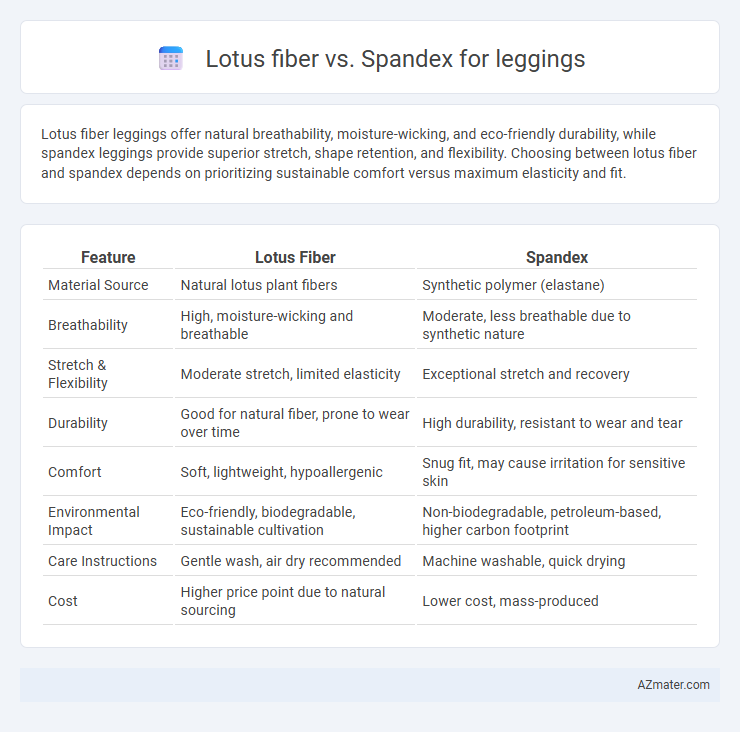Lotus fiber leggings offer natural breathability, moisture-wicking, and eco-friendly durability, while spandex leggings provide superior stretch, shape retention, and flexibility. Choosing between lotus fiber and spandex depends on prioritizing sustainable comfort versus maximum elasticity and fit.
Table of Comparison
| Feature | Lotus Fiber | Spandex |
|---|---|---|
| Material Source | Natural lotus plant fibers | Synthetic polymer (elastane) |
| Breathability | High, moisture-wicking and breathable | Moderate, less breathable due to synthetic nature |
| Stretch & Flexibility | Moderate stretch, limited elasticity | Exceptional stretch and recovery |
| Durability | Good for natural fiber, prone to wear over time | High durability, resistant to wear and tear |
| Comfort | Soft, lightweight, hypoallergenic | Snug fit, may cause irritation for sensitive skin |
| Environmental Impact | Eco-friendly, biodegradable, sustainable cultivation | Non-biodegradable, petroleum-based, higher carbon footprint |
| Care Instructions | Gentle wash, air dry recommended | Machine washable, quick drying |
| Cost | Higher price point due to natural sourcing | Lower cost, mass-produced |
Introduction to Lotus Fiber and Spandex
Lotus fiber, derived from the stem of lotus plants, offers natural breathability, moisture-wicking properties, and biodegradability, making it an eco-friendly choice for leggings. Spandex, a synthetic fiber known for its exceptional elasticity and shape retention, provides superior stretch and comfort in activewear. Combining lotus fiber's sustainability with spandex's flexibility results in leggings that balance environmental benefits with performance.
Origin and Production Processes
Lotus fiber leggings are crafted from natural fibers derived from lotus stems, harvested primarily in Southeast Asia through an eco-friendly and time-intensive process that involves extracting fibers by hand and spinning them into yarn. Spandex leggings are made from synthetic polyurethane polymers produced via a chemical process involving the polymerization of monomers, typically originating from petroleum-based raw materials. The production of lotus fiber emphasizes sustainable agriculture and artisanal techniques, while spandex manufacturing relies on industrial-scale chemical synthesis and plastic engineering.
Environmental Impact and Sustainability
Lotus fiber leggings offer a biodegradable and renewable alternative to spandex, significantly reducing microplastic pollution in oceans. The cultivation of lotus plants requires minimal pesticides and water, enhancing soil health and promoting biodiversity compared to synthetic spandex production reliant on petrochemicals. Choosing lotus fiber supports sustainable fashion by lowering carbon footprints and fostering eco-friendly manufacturing processes.
Comfort and Breathability Comparison
Lotus fiber leggings offer exceptional breathability due to their natural moisture-wicking properties, keeping the skin cool and dry during extended wear. Spandex leggings provide superior stretch and flexibility but tend to trap heat and moisture, which can reduce overall comfort in intense activities. Choosing lotus fiber enhances ventilation and comfort, making it ideal for those seeking breathable, eco-friendly activewear.
Stretchability and Flexibility
Lotus fiber leggings offer moderate stretchability and high breathability, providing natural flexibility with eco-friendly properties but limited elasticity compared to synthetic fabrics. Spandex leggings are renowned for exceptional stretchability and superior flexibility, allowing for a snug fit and extensive freedom of movement during physical activities. When comparing stretch and flexibility, spandex outperforms lotus fiber, making it the preferred choice for performance-driven leggings.
Moisture-Wicking and Quick-Drying Properties
Lotus fiber leggings excel in moisture-wicking and quick-drying due to their naturally porous structure that absorbs sweat efficiently and promotes airflow. Spandex, while stretchy and comfortable, lacks inherent moisture management, often relying on blends with synthetic fibers to enhance drying speed. Lotus fiber provides a sustainable, breathable alternative that keeps skin dry and cool during intense workouts.
Durability and Longevity
Lotus fiber leggings offer natural durability and breathability, making them a sustainable choice with moderate resistance to wear over time. Spandex leggings provide exceptional elasticity and resilience, resulting in superior longevity and shape retention even after frequent use and washing. For long-lasting performance, spandex blends typically outperform pure lotus fiber in maintaining fabric integrity and stretchability.
Skin Sensitivity and Hypoallergenic Qualities
Lotus fiber leggings offer superior skin sensitivity benefits due to their natural, breathable, and hypoallergenic properties, reducing the risk of irritation and allergic reactions compared to synthetic materials. Spandex, while highly elastic and form-fitting, may cause discomfort or skin sensitivity issues for individuals with delicate or allergy-prone skin because it is often blended with synthetic fibers. Choosing lotus fiber leggings enhances comfort for sensitive skin by providing a natural alternative that promotes better moisture absorption and reduces exposure to potential allergens.
Style, Texture, and Aesthetic Appeal
Lotus fiber leggings offer a unique, natural texture with a soft yet slightly coarse feel, creating a distinctive matte finish that enhances a bohemian or eco-friendly style. In contrast, spandex leggings have a smooth, sleek texture with high elasticity, providing a glossy, form-fitting aesthetic ideal for activewear or contemporary fashion. The subtle earthiness of lotus fiber appeals to those seeking sustainable, artisanal elegance, while spandex emphasizes dynamic movement and a polished, urban look.
Cost and Market Availability
Lotus fiber leggings generally have a higher cost due to the labor-intensive process of extracting and weaving fibers, making them a premium sustainable option with limited market availability primarily in niche eco-friendly brands. Spandex leggings are widely available and cost-effective, benefiting from mass production and extensive use in athletic and casual wear markets. The significant price difference reflects the scarcity and artisanal nature of lotus fiber compared to the synthetic, affordable scalability of spandex.

Infographic: Lotus fiber vs Spandex for Legging
 azmater.com
azmater.com